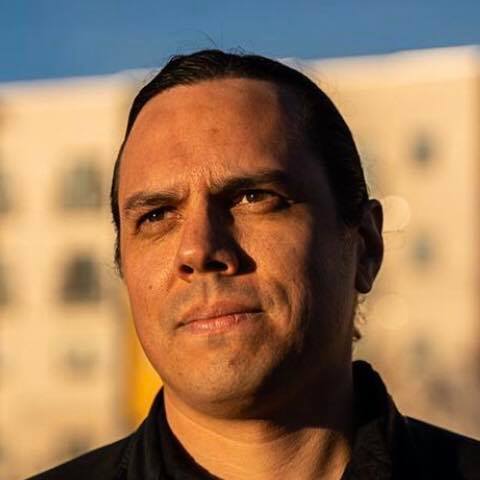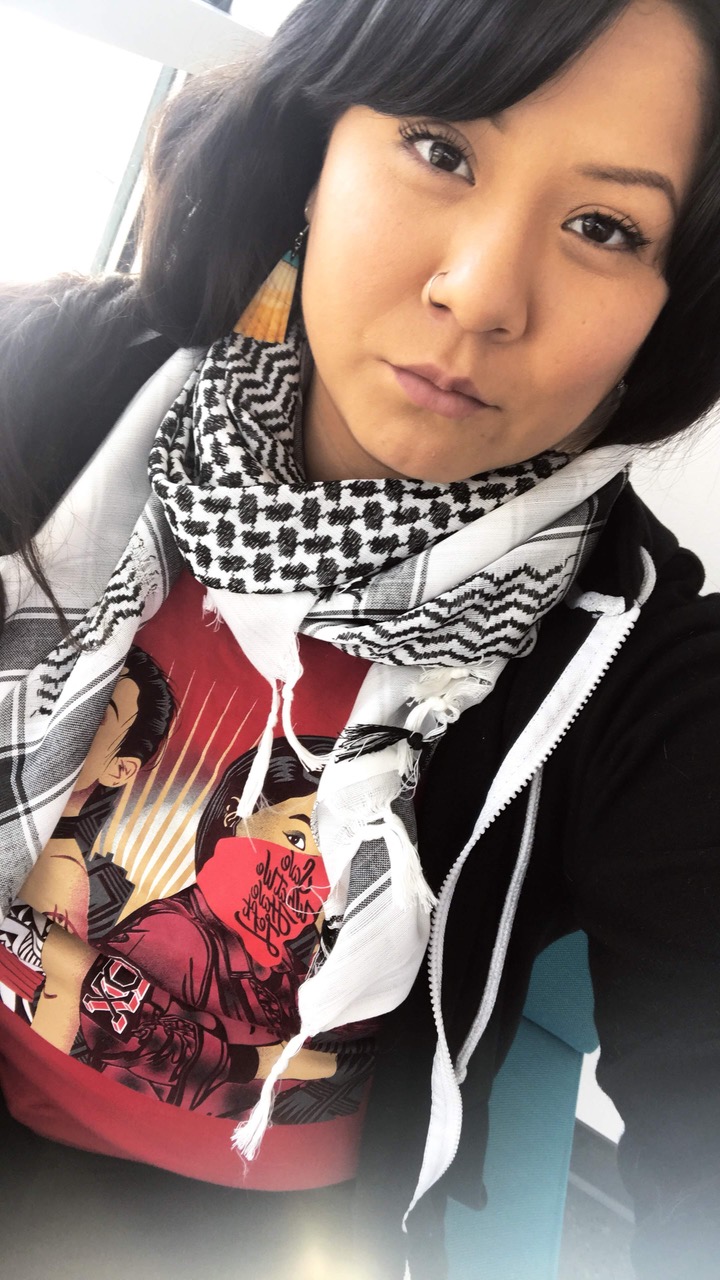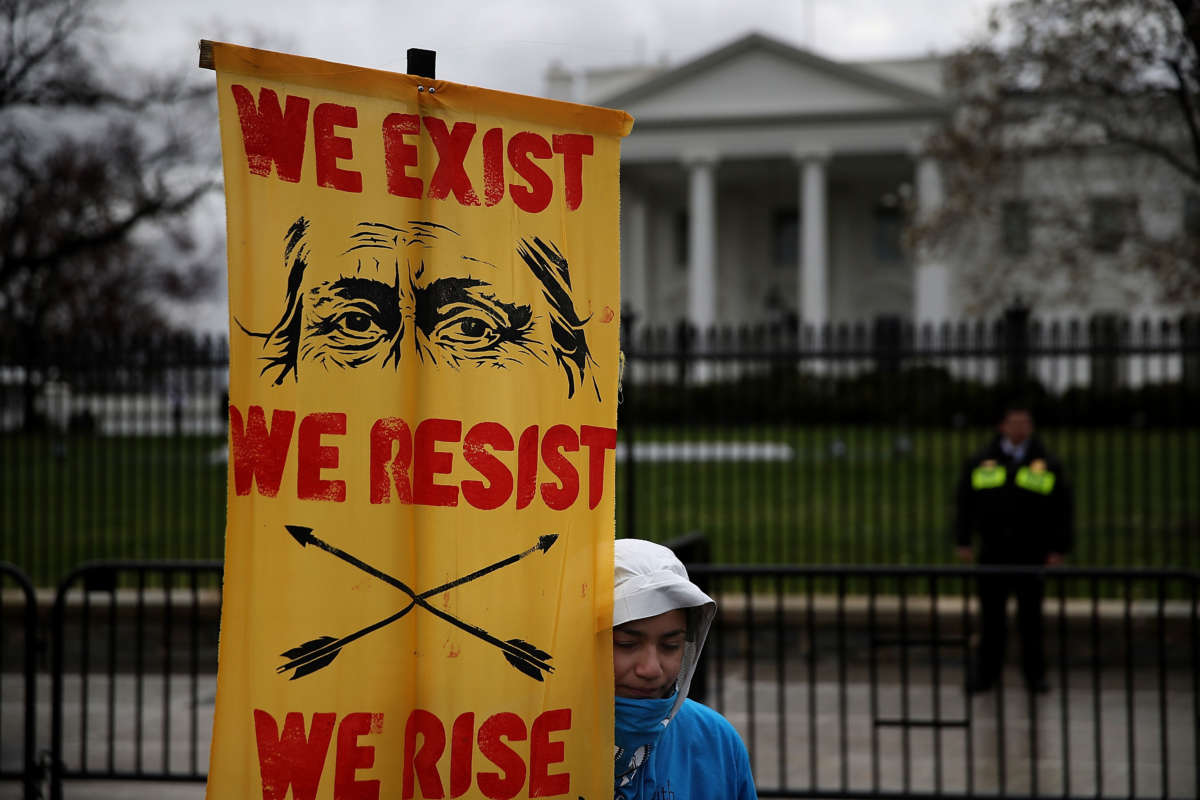Part of the Series
Despair and Disparity: The Uneven Burdens of COVID-19
Did you know that Truthout is a nonprofit and independently funded by readers like you? If you value what we do, please support our work with a donation.
The United States is in the midst of the COVID-19 pandemic, which has infected more than 1.2 million people and claimed over 70,000 lives. President Donald Trump has failed the American public, bungling the response while forsaking and targeting vulnerable communities. Meanwhile, the hopes for a progressive insurgency have faded with Sen. Bernie Sanders’s withdrawal from the race for the Democratic nomination for president.
Indigenous people have been here before. White supremacy, capitalism, patriarchy and settler colonialism have systematically erased Indigenous communities, culture and voices, while confiscating their lands. Throughout their history of colonization, they have faced a variety of structural oppressions with clear lessons for the current crises.
Truthout spoke with Indigenous activists Nick Estes and Justine Teba, who present an Indigenous framework for understanding the contemporary predicaments in the United States and the world. Estes, a member of the Lower Brule Sioux tribe, is also assistant professor of American studies at the University of New Mexico and co-founder of The Red Nation, a grassroots radical leftist Indigenous organization based in Albuquerque, New Mexico. Teba, of the Tesuque and Santa Clara Pueblo, is co-founder of the Pueblo/a/x Feminist caucus within The Red Nation.
Yoav Litvin: How is the global COVID-19 pandemic affecting Native communities? What has the response been like from the government? Are there parallels to the historical use of contagious diseases as part of the colonial genocidal process?
Nick Estes: The primary organizing principle of a settler society is the elimination of the Native, whether it is in Palestine or the United States. Thus, the organizing structure of the United States’ economy and its political institutions is based around disenfranchisement of Indigenous people — politically, economically and physically.
There is a common myth in U.S. history that most Indigenous people did not die because of active killing, warfare and genocide, but rather as a result of outbreaks: smallpox, measles and cholera. However, these epidemics occurred and intensified in times of war, which meant mass forced starvation, depravation of resources, such as access to sanitary conditions — water, food, shelter — or the dependence on rations as the means of survival. The conditions of war were created by design to intensify these outbreaks of contagious diseases. In fact, epidemiologist Dean S. Seneca claims Indigenous people have the most experience with bioterrorism as it relates to infectious disease. The river tribes that were along the Missouri River were either purposely infected and/or traders did nothing to prevent the spread and devastation. For example, the Mandan, Hidatsa and Arikara tribes had extremely high death rates because of smallpox. Indigenous people knew how they spread and that traders carried inoculations, which were purposefully withheld. We would split up into smaller sections and disperse over a certain amount of time while regrouping later.
If we look at the response now to COVID-19, it has some parallels to this history. The health care system afforded to Native communities is based on the integrity of the fiduciary, fiscal and federal responsibilities of the U.S. government to uphold treaties. The integrity of those treaties [is] only worth what we get out of them in return for all the bloodshed and the land stolen, annexed and expropriated from us. If you look at the last appropriations bill — the stimulus bill – a very small fraction went to Indigenous people, intensifying rates of infection and death because the Indian health care system was never meant to work in the first place. What’s more, dominant settler society devalues elders. The lieutenant governor of Texas, Dan Patrick, outrageously claimed older people were pretty much expendable. That sort of sentiment is anathema to Indigenous folks.

The continued cheapening of Indigenous health, since the ‘70s and before, does not only affect us, but surrounding communities as well. When you examine the Navajo Nation, which is larger than the state of West Virginia, you have the third-largest infection rate after the states of New York and New Jersey, higher not just on the reservation but also off it; approximately 70 percent of Indigenous people do not live on reservations but in the inner city. Thus, any pandemic is not just confined to a geographical location. For example, one-tenth of the Navajo Nation’s population lives in Albuquerque, extending the tribal health care issue into the city. On mainstream media, you constantly see New York Gov. Andrew Cuomo rightfully criticizing the federal response to COVID-19. However, Jonathan Nez, president of Navajo nation, does not receive comparable airtime, nor does his nation.
The stimulus package categorically excludes Indian casinos, the 13th-largest employer in the U.S.
Donald Trump has made a career of trying to disestablish tribes, most notably before Congress claiming Native American casinos are run by the mob. Mashpee Wampanoag had 300 acres of their land taken out of trust under Trump’s administration, the first time since the termination era, and under the secretary of interior and the assistant secretary of Indian affairs, Tara Sweeney who is a former oil lobbyist. The tribe was threatening economic development through casinos, which is one of the few paths tribes have for economic development. Without land, Indigenous people might not qualify for the federal resources for health care infrastructure or housing.
What are “blood quantum” laws and how do they contribute to “toxic traditionalism”? Why do women and queer folk pose a threat to American hegemony?
Justine Teba: Prior to colonization, we were part of our own civilizations with politics and governance structures, which were also inclusive of women and LGBTQ2 (Lesbian, Gay, Bisexual, Transgender, Queer and Two-Spirit) folks.
Indigenous people had to adopt colonial values into their already existing structures as a means of survival. Our colonizers refused to deal with existing Indigenous leadership, which included women and LGBTQ2 folks, and so they chose the leaders. In New Mexico, the Spanish and later the Americans gave the canes to cis-hetero-men — leaders in their oppressive image. Women and LGBTQ2 groups still remain out of leadership. Since colonization, there have only been two female governors.
“Toxic traditionalism” refers to destructive colonial values entangled with Indigenous practice and politics. We then misguidedly honor these practices because they have become traditional over time. Toxic traditionalism is often used as a deliberate weapon or means of oppression for the most marginalized people within Indigenous communities — usually women, LGBTQ2 folks and children.

Blood quantum laws are another form of toxic traditionalism. They originated in the early 1700s yet were not in full practice until the Indian Reorganization Act of 1934, with the explicit goal of cultural assimilation of Indigenous folks into colonial society. These racist laws were another form of genocide, continuing Andrew Jackson’s Indian Removal Act of 1830.
Prior to colonization, we had our own ways of relation, which were honored through mothers and existing structures of kinship, like clans. In the landmark case Santa Clara Pueblo v. Martinez (1978), Julia Martinez fought for her daughter to be registered in the Pueblo. Martinez was a “full-blooded” person from Santa Clara, yet the father of her child was a non-member; therefore, her child was excluded. If the father were a “full-blooded” member, the child would be included.
My blood quantum includes quite a few tribes and I have kinship in all these places. However, my blood quantum is not enough in any single tribe, so even though I am full-blooded Indian, I am not recognized as a Native American. My kinship to people, places and practices is what makes me Indigenous, not blood quantum.
What are your opinions of the current political status? Are U.S. electoral politics relevant to your struggles?
Teba: Obama’s response to the Standing Rock movement squashed any hope I once held for the settler state. As an Indigenous person, my very existence is a contradiction to the logic of the settler state. The current presidential competition is between Red Trump and Blue Trump. It’s not a real choice.
Estes: It is important to understand that Indigenous people, by and large, are further left in their political orientation than any other demographic in this country, at least in certain regions. Pine Ridge, South Dakota, for example, exists as one of the poorest counties in the nation in a sea of red counties, yet it overwhelmingly voted for Obama. Indigenous people are not wedded to the Democratic Party; we simply understand the threat of the Republican Party.
Indigenous people control large sections of land, yet when people talk about “rural voters” they rarely mention us.
Native voters suffer from continual disenfranchisement. For example, the state of North Dakota implemented unconstitutional voter registration laws requiring a street address in retaliation for Standing Rock. Most people on the reservation do not have a street address, and use a P.O. box, and so these folks were categorically disenfranchised.
Electoral campaigns tend to suck the oxygen out of the room at key moments. Standing Rock in 2016 did not receive much attention until Sanders lost the nomination. Recently, we witnessed a mass uprising in so-called Canada by the Wet‘suwet’en Nation, who were violently evicted from their homelands for trying to build a healing center on the route of a natural gas pipeline. The uprising shut down large sections of the economy there, costing billions of dollars to associated industries and resulting in mass layoffs, nearly bringing the country to a grinding halt. The protests were barely mentioned by the Sanders campaign or the Green New Deal promoters. In contrast, we witnessed a celebration of Greta Thunberg, a 14-year-old Swedish girl who was saying the same things as Indigenous land defenders.
What is your view of leadership as Indigenous organizers? How do you prioritize your struggles?
Teba: Leaders in the U.S. are oppressors, including Democrats. When I think of leaders, I think of people who run in Indigenous-led movements. Truth-tellers are leaders. They inspire change. Those at Standing Rock were truth-tellers and they inspired me into action.
Estes: Party leaders have always given priority to economic and corporate interests over social movements. Change from within is an illusion. That is simply how class works. We need to construct power from below by elevating a candidate who is a product of social movements, not the corporate party structure.
Indigenous Bolivian ex-President Evo Morales famously said that his primary sin was his identification as an Indian, a leftist and an anti-imperialist. Jessie Little Doe Baird, the vice chair of the Mashpee Nation, similarly claimed the original sin of the Mashpee people who welcomed the colonizers in the mythologized first Thanksgiving was simply existing. Thus, instead of trying to seek recognition from people who want our annihilation, we take the example from the South – the Movement Toward Socialism (MAS), which was the vanguard of the environmental justice movement.
The intersection of identities must incorporate class as a means of understanding the power and racial oppression within a settler colonialist society. Oppressed communities in the U.S. – Black, Indigenous, migrants — benefit from collectively building power through our communities rather than begging those in power to recognize our issues. We do not need more Brown faces in high places. Obama best represents this paradox.
Our struggles are dictated by the agendas of our communities (see The Red Deal). The Red Nation and many Indigenous groups had constructed mutual aid networks well before the abandonment by the state during the present epidemic. Indigenous communities already participate in informal economies set up to sustain us in light of the government’s ineptitude.
Talk about contemporary struggles not receiving sufficient media attention.
Teba: Here in New Mexico, Trump’s bump in spending and lift on Environmental Protection Agency regulations have had particularly devastating effects. In Los Alamos National Laboratory, nuclear colonialism manifests itself, ironically in our sacred mountains. Recently, the Los Alamos National labs stated they would release radioactive Tritium vapors into Tewa lands and airspace. Trump’s policy changes have also created a boom in the fracking industry. Our Democratic Gov. Lujan Grisham has ramped up fracking to pay for college.
It is crucial to remember our struggles are global. The United States, whether led by Republicans or Democrats, uses oil as a means of dictating the global economy by increasing production and transfer through polluting pipelines and placing sanctions on competitors such as Venezuela, Iran and Russia.
Estes: Many of our struggles are connected to the global commodity supply chain of oil. The U.S. promotes a subsidized government response attempting to artificially control prices. The waning of U.S. hegemony is leading to intensification of extraction projects.
Here in the Southwest, oil comes from the Permian Basin, while up north, oil from the Bakken formation flows through the Standing Rock Indian Reservation via the Dakota Access Pipeline. The Alberta tar sands in so-called Canada has created a dead zone with a surface area the size of Florida, which is dry-feeding into pipelines traveling through Wet’suwet’en territories, including my people’s area in the Lakota territory.
The construction of these pipelines exemplifies the death drive of the oil economy. TC Energy, formerly TransCanada Corporation, recently began constructing the Keystone XL pipeline on the U.S. side of the border. CGL Network’s workers did not stop working on the pipeline even in the midst of the pandemic, meaning thousands of workers from the outside now reside in and endanger these geographically isolated, under-resourced areas, which are primarily Indian reservations.
Meanwhile, Kristi Noem, the governor of South Dakota, introduced TC Energy-drafted legislation to criminalize Lakota water protectors trying to fight the Keystone XL Pipeline. Unsurprisingly, Noem also refused to issue a stay-at-home order for workers and their families infected with COVID-19 at a meat packing plant in Sioux Falls, South Dakota. Noem demonstrates how capitalism will eventually affect white people as well; she is literally asking white workers to sacrifice themselves. Regardless of whether they support Indigenous struggles, they are paying the price for the structurally racist corruption which oppresses us.
Has the reactionary nature of the Trump administration created positive changes in people’s attitudes?
Teba: People are getting radicalized due to all of the failings of the state, which are under a magnifying glass. On the flip side, the successes of socialist countries are magnified. And so, there’s a momentum going and it’s crucial that groups like The Red Nation continue organizing. This is a pivotal time.
Estes: There is a humbling process happening now. We need to become internationalists and relinquish U.S. exceptionalism.
Many people who invested hope in the Sanders campaign are feeling alone and disillusioned. At the end of the day, The Red Nation will continue to build real alternatives for our people. It is necessary for our survival.
The COVID-19 pandemic is much like the climate crisis: we saw it coming, scientists warned us about it, and we did nothing to prepare. The U.S. response to COVID-19 is a global health risk. And who is at the front lines of all of these crises? Indigenous people. Ignore us at your own peril. If you actually believe in a future for this planet, it is literally decolonization or extinction.
This interview has been edited for clarity and length.
Media that fights fascism
Truthout is funded almost entirely by readers — that’s why we can speak truth to power and cut against the mainstream narrative. But independent journalists at Truthout face mounting political repression under Trump.
We rely on your support to survive McCarthyist censorship. Please make a tax-deductible one-time or monthly donation.
